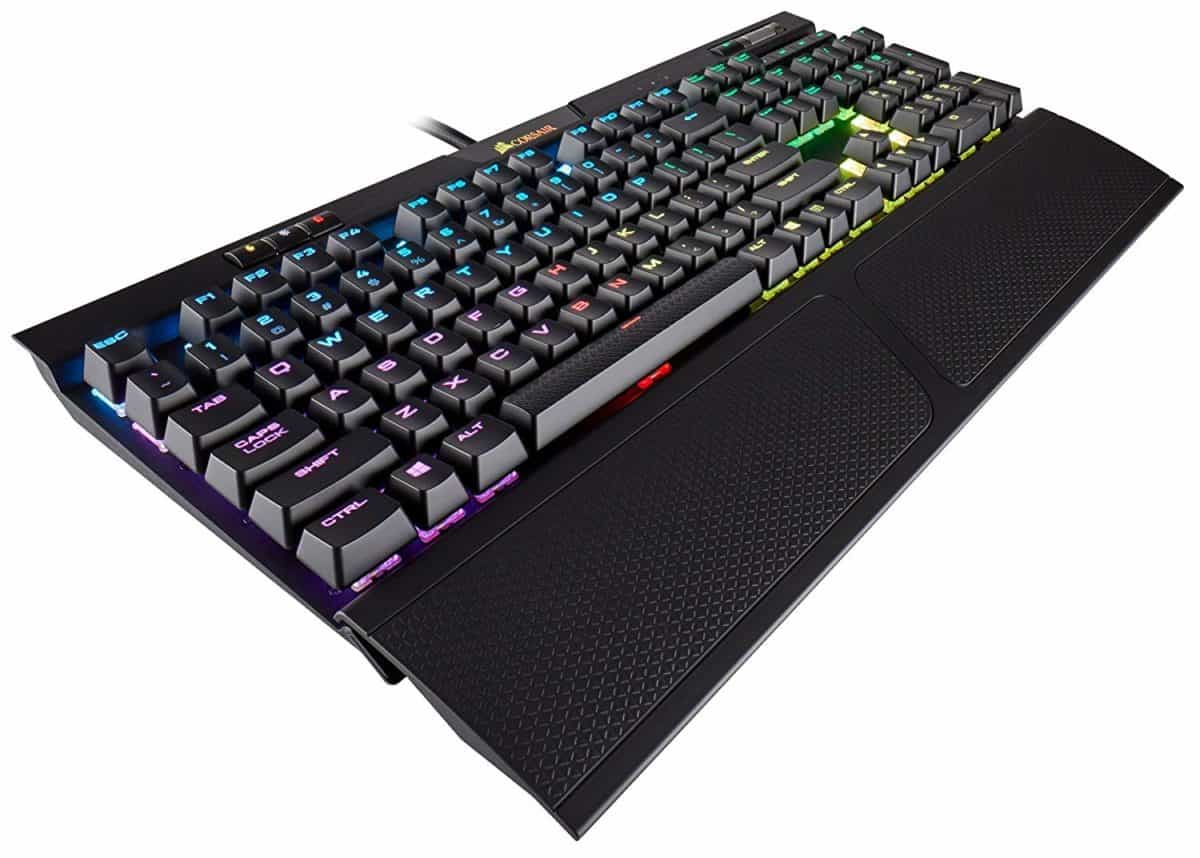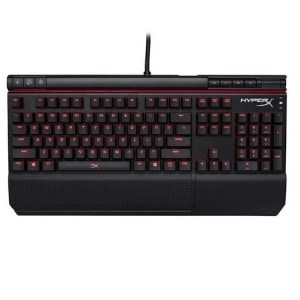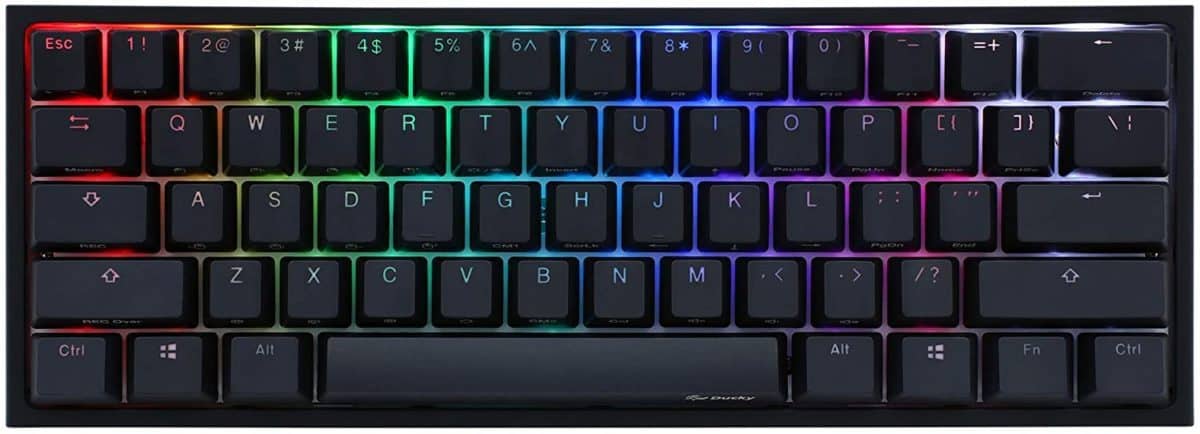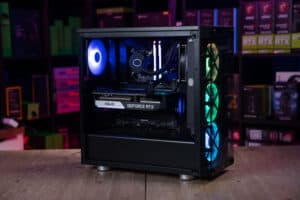Cherry MX Switches Guide
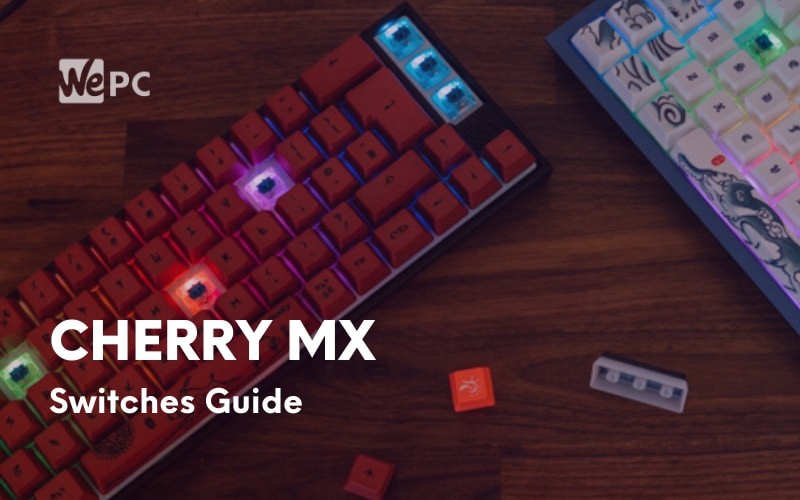
WePC is reader-supported. When you buy through links on our site, we may earn an affiliate commission. Prices subject to change. Learn more
Cherry MX switches are the most popular mechanical switch in the world, and there is a huge variety of them too, ensuring every gamer’s keyboard is custom-tuned to their liking. When searching for a new gaming keyboard, some may be a little overwhelmed by the number of options on offer from manufacturers. Even overly ergonomic boards such as split keyboards have begun to feature genuine Cherry MX Switches by now. You might even want to ask ‘what is a mechanical switch, and which is best for gaming?’ This guide aims to answer all your questions, and more. For those of you wondering about the most popular Cherry MX Switches, head over to our Cherry MX Blue vs Red guide for a more in-depth battle between those switches.
What Is A Mechanical Switch?
Mechanical switches utilize a stem and moving contacts, actuating a keypress when the current is broken between the metal contacts. Traditional membrane/rubber dome switches actuate or register a keypress when the dome is fully compressed and reaches the bottom, where finally the contacts meet. On a mechanical keyboard, switches actuate prior to bottoming out, allowing for shorter key travel and faster actuation.
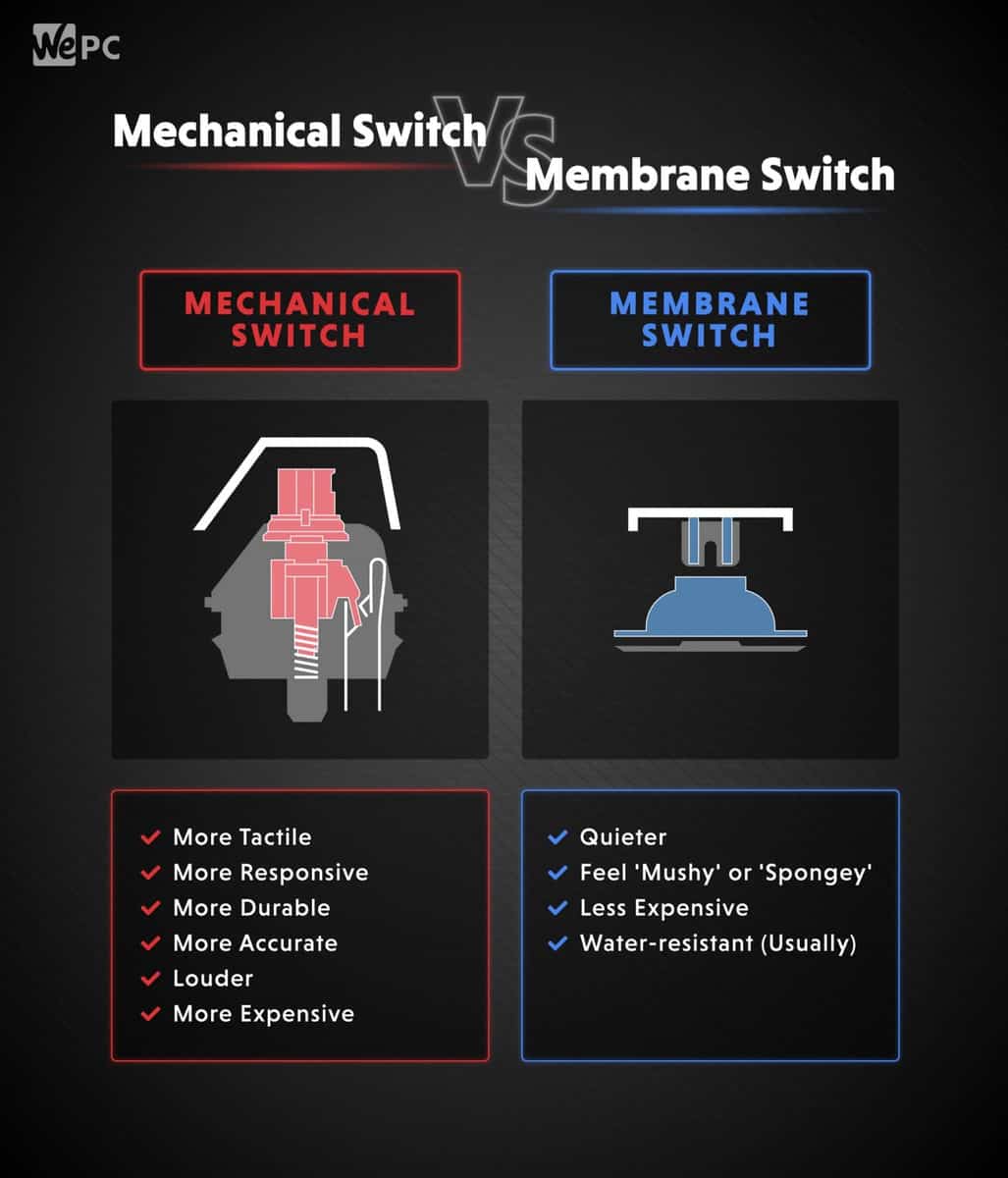
The main benefit of mechanical switches is the typing feel. Membrane and rubber dome keyboards are known to feel “mushy”, “squishy” and unpleasant. Mechanical switches typically feel much snappier, having a smooth, consistent keystroke. Mechanical switches also come in a vast variety of both switch design and key feel.
What Are Cherry MX Switches Then?
Cherry is a German manufacturer, most well known for its widespread lineup of Cherry MX mechanical key switches. Cherry MX switches can be found in almost all high-end gaming keyboards, even from large brands such as Corsair and SteelSeries. With an estimated lifespan of 50 million keypresses, they are much more reliable and durable than standard rubber domes.
First produced in 1983, MX switches are comprised of switch housing, a stem, spring, and internal contact leaves. Cherry MX switches are actuated when the stem pushes the contact leaves apart, breaking off the connection.
MX switches have a “plus” like stem design (+), which can fit almost all of the third party keycap sets on the market. There are three types of MX switches – Tactile, Linear, and Clicky variants. MX Blues, Browns, and Reds are most common in gaming keyboards due to the lower actuation force. However, there are a plethora of other different MX-switch types.
Let’s take a look at the different types.
Linear Cherry MX Switches
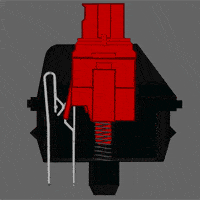
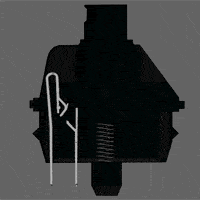
Linear MX switches include MX Reds, MX Blacks, MX Linear Greys, MX Nature Whites, and MX Speed Silvers. Linear switches have a consistent, uninterrupted keystroke, smooth from the top to bottoming-out. They are also usually the quietest of the three. Linear switches are great for both typing and gaming.
The Cherry MX Black switches were one of the first produced by the company back in the 1980s, receiving an update since then (obviously). Out of all the standard Cherry MX switches they are one of the stiffest, with an actuation force of 60 cN. Black switches have the responsiveness for gaming and are superb to type with, but they are considerably “heavier” than the alternatives. The heavy actuation is great for those that have a habit of making typos or making accidental keypresses mid-game.
Cherry MX Red switches work in much the same way the Black variant does except with quicker actuation thanks to the low actuation force of 45 cN. Cherry MX reds are favored among the competitive gaming community, registering a keypress quicker than most other switch types.
Cherry MX Speed Silvers have grown in popularity with gamers thanks to the reduced travel time during a keypress. The travel distance of the key has been shortened from 4.0mm (Cherry MX Reds) to3.4mm, technically allowing for faster actuation.
| Switch Variant | Switch Type | Actuation Force | Actuation Distance | Travel Distance |
|---|---|---|---|---|
| MX Red | Linear | 45g | 2.0mm | 4.0mm |
| MX Black | Linear | 60g | 2.0mm | 4.0mm |
| MX Linear Grey | Linear | 80g | 2.0mm | 4.0mm |
| MX Nature White | Linear | 55g | 2.0mm | 4.0mm |
| MX Speed Silver | Linear | 45g | 1.2mm | 3.4mm |
| MX Silent Red | Dampened Linear | 45g | 2.0mm | 4.0mm |
| MX Silent Black | Dampened Linear | 60g | 2.0mm | 4.0mm |
| MX Lo-Pro Red | Low Profile Linear | 45g | 1.2mm | 3.2mm |
| MX Lo-Pro Speed | Low Profile Linear | 45g | 1.0mm | 3.2mm |
Tactile Cherry MX Switches
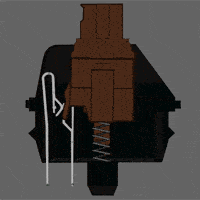
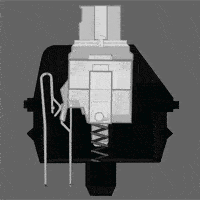
Tactile MX switches include MX Browns, MX Clears, and MX Tactile Greys. Tactile switches have a slanted leg on the stem, which results in a bump around halfway through the keystroke. Once the switch is actuated, the bump registers tactile feedback. Tactile switches are fairly quiet, and suitable for both gaming and typing.
Cherry MX Brown switches are probably the most popular of the tactile variety, mostly thanks to their availability. The browns can be considered the middle ground, with a light 45 cN actuation force like the Reds, only with that satisfying tactile bump.
Cherry MX Clears are very similar to the Browns but with a heavier actuation force of 65cN required. These feel like they have more of a bump during the keypress and are excellent for both typing and gaming – if you can get your hands on them.
Cherry MX Grey switches tend to be less common and are similar to Browns with a slightly firmer feel. These operate with a force of 80 cN and can be a good alternative for those that get a little heavy with their fingers.
| Switch Variant | Switch Type | Actuation Force | Actuation Distance | Travel Distance |
|---|---|---|---|---|
| MX Brown | Tactile | 45g | 2.0mm | 4.0mm |
| MX Clear | Tactile | 55g | 2.0mm | 4.0mm |
| MX Tactile Grey | Tactile | 80g | 2.0mm | 4.0mm |
Clicky Cherry MX Switches
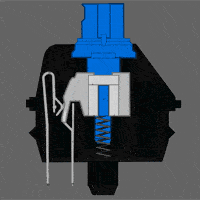
Clicky MX switches include MX Blues, MX Greens, and MX Whites. Clicky MX switches have a click-jacket on the stem of the switch, which snaps back once pressed down halfway through the keystroke, resulting in a sharp tactile bump. They are by far the loudest, with high-pitched, audible feedback. Clicky MX switches are great for typing, but the design of the switch makes it prone to hysteresis when repeatedly tapping at keys, resulting in unregistered keypresses, making them not very suitable for gaming.
Cherry MX Blue switches are the most widely available and known clicky style switch. The actuation force is 60 cN and are really satisfying if you don’t mind the audible noise. These are very loud so they should probably be avoided in an office environment.
Cherry MX Green switches are very similar to the Blues but come with a heavier actuation force of 80 cN. The pre and total travel remain the same but these are suited to those that prefer a heavier keypress or make the odd typo.
Cherry MX White switches are a less common variant compared to the others but feel similar to the Greens. The actuation is still at 80 cN but these perform with a more with a quieter click.
| Switch Variant | Switch Type | Actuation Force | Actuation Distance | Travel Distance |
|---|---|---|---|---|
| MX Blue | Clicky | 50g | 2.0mm | 4.0mm |
| MX Green | Clicky | 70g | 2.0mm | 4.0mm |
| MX White (Old) | Clicky | 50g | 2.0mm | 4.0mm |
| MX White (New) | Clicky | 70g | 2.0mm | 4.0mm |
Notable Cherry MX Switches
Cherry MX Silent switches used to also be exclusive to Corsair-branded keyboards, featuring rubber dampeners on various parts of the stem to minimize bottom-out noise. MX Silent switches are available in either Red or Black linear variants. The rubber dampeners do significantly reduce the sound production, and may even be quieter than standard membrane keyboards, but the dampening does affect the typing experience, making the switch feel more “mushy” or “soft” with a cushioned bottom-out.
Cherry’s most recent addition to the MX lineup is the Low Profile MX switches. These have a circular stem design, and though the stem design fits standard keycaps, normal keycaps aren’t usable, as they are too tall. The Low Profile MX switches have a total travel of 3.2mm, and while the Red variant has an actuation distance of 1.2 mm, the Corsair-exclusive Speed variant has an actuation distance of only 1 mm.
MX Switch Revisions
There have been three major Cherry MX Black revisions. MX Blacks were first produced in the 1980s, and they have continued in production until the 1990s when the materials and tooling were slightly altered. These early switches are called “vintage blacks”, and are sought after for their smoothness. The change in materials was mainly to reduce manufacturing costs, but the alteration caused the “new” revision to suffer from scratchiness. Called “pre-retooled” blacks, these are the least desirable variant. Finally, in 2016, Cherry once again updated their tooling, producing much smoother “retooled blacks”. Retooled blacks have stem, housing, spring, and contact leaf adjustments, making the smoothness comparable to vintage switches.
Aside from MX Blacks, the lineup of MX Reds, MX Blues, and MX Browns have also been minorly retooled, in around 2016. Retooling has made each of them smoother and less scratchy, as well as slightly increasing the tactility of MX Browns and MX Blues.
MX Switch Clones
When Cherry’s patent for the MX switch design expired in 2013, a plethora of MX clones flooded the market, from manufacturers such as Kailh, Outemu, and Gateron. In the beginning, Cherry MX clones were usually inferior and had worse quality. However, within the past few years, certain cloned switches have greatly improved. For example, Gateron’s MX clones are known to be smoother and have less key wobble than genuine Cherry MX, and are similar or sometimes cheaper in price. Overall, MX clones are a great choice as an alternative for mechanical key switches.
Final Word
Mechanical switches are usually superior and more durable than rubber dome switches, with Cherry’s MX lineup being no exception. Although there are hundreds of MX-style switches, there is no such thing as the “best switch”. It’s all up to preference. Prior to buying a mechanical keyboard, I’d recommend buying a switch tester, to try out multiple variants of switches and see which ones are best for you. Investing in a well-built, reliable mechanical keyboard can enhance both your typing and gaming experience to no end, as well as generally being more durable than a membrane keyboard.
What switch type did you go for with your new mechanical keyboard? Are you sticking with your membrane style board? Head over to the WePC community and share what Cherry MX switches you went for or if you prefer one of the affordable MX clones, which do you consider the best?

